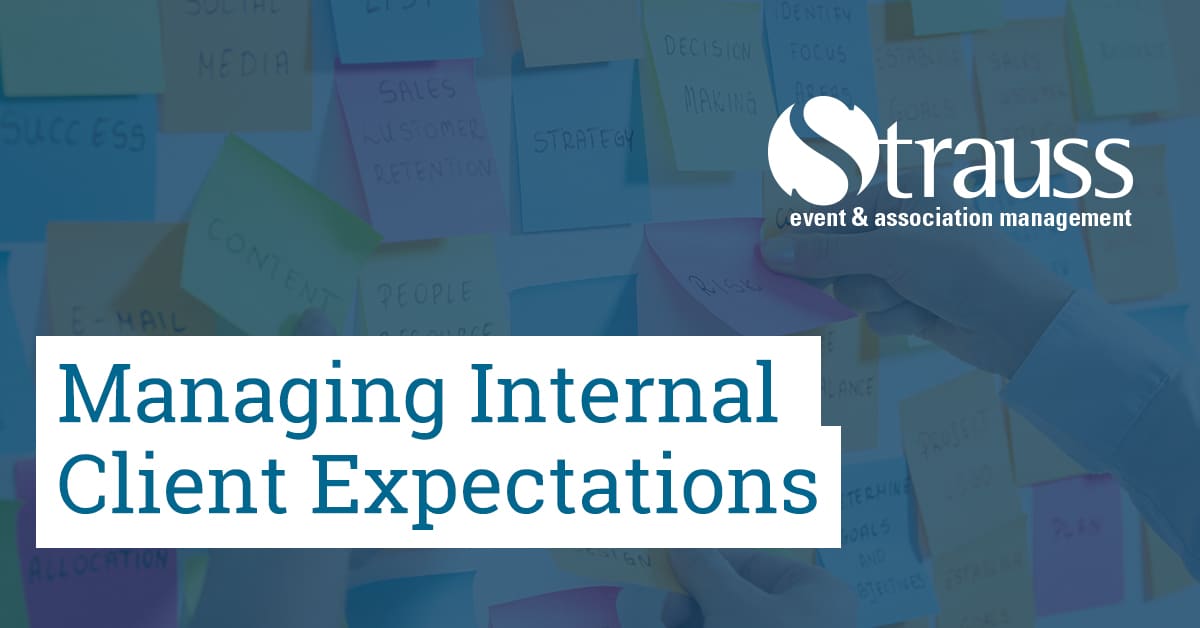As an Event Manager, I plan and execute many events for association and non-profit clients. Most of the time, I am working with individuals, fellow staff members or committees who represent the client, which means I am always working with new people. Working with a senior staff member from your own organization in particular puts you in an interesting position: you are both part of the same organization, working as colleagues, but this person is also your client.
Doing so, you not only enter into a relationship with your client—whether internal or external—you also embark on a close collaborative relationship that will have its ups and downs, like any relationship. For more on this, read Relationship Building with Association Stakeholders. Here are some ways you can ensure that both you and your client can work together to get to the desired goals of the conference, fundraiser, or other type of association event you have been brought on to manage.
Establish a Mutual Understanding
Before you get too deep into the details of the event, make sure you understand the client’s goals for the event. For example, is it a fundraiser designed to meet the operational expense requirements of the organization, or is it designed mainly to build the profile of their organization in the community?
In the case of an internal client, you both already “play for the same team” but it is still important to establish a mutual understanding between you and your colleague(s). You can do this by finding common ground and being open about expectations when all parties come to the table in the planning stages of the event.
Honesty is Key
When you are ready to share the critical path of the event with your client, be honest about what you can and cannot deliver. A good motto to live by is “under-promise and over-communicate,” which is really to say that it is crucial that you do not over-promise in setting the deliverables, timelines, and goals of the event with your client. This is to avoid their disappointment when reality sets in and they find out that some goals may be unreachable.
Keep Communication Channels Open
While you can never really “over-communicate” with any client, it is vitally important to put the time in from Day One. Get to know them. It is much easier to work in a friendly atmosphere for the weeks or months you will be interacting with the client and/or organizing committee members. If you can find common ground with them at the outset, this will help you to figure out the best way to work with them to help the association achieve its goals.
To keep those communications channels open, go beyond the regularly scheduled progress meetings to set up weekly check-ins via email and even monthly in-person meetings. If you are in the same office, then this will be easier to do. If your colleague works remotely, then in-person meetings may be out of the question. Do what you can and use technology to facilitate your conversations. For more on communicating clearly and concisely, read my colleague’s article.
These extra meetings are often the times where misunderstanding and oversights come to light, and the sooner you set these straight, the better for everyone involved. This is especially true when you have more than one internal client to work with on an event, and both are senior staff members with conflicting opinions. If this happens, my best advice is to draw them together and diplomatically point out their information is conflicting, then let them try and sort it out between them.
Good communication with the client will make all of the decisions, and occasional bad news, easier to deliver and accept. Difficult decisions need to be made sometimes and often the client’s expectations exceed the possible, but if you have developed a good rapport with them, you will be making it easier to explain the reasons behind the cost, timing, and venue decisions that you will make together.
Other Steps to Take
There are a few other things you can do to help maintain that amicable and collaborative relationship. You should provide specific dates on the event’s critical path, but you should also add some padding to the deadlines you set: communicate a deadline that is a few days ahead of the actual deadline to ensure on-time deliverables of signage, printing, etc. Another way to avoid stressful bumps along the road is to make sure your cost quotes are accurate and within budget. As staff members for the same association, you and your client will likely have similar intentions of keeping costs down.
In the end, it is all about managing internal client expectations. The more information you share with the client throughout the planning process, the more they learn about the realities of putting on the event, and, hopefully, your colleague(s) will take those lessons to heart when you work with them to organize events year after year.

